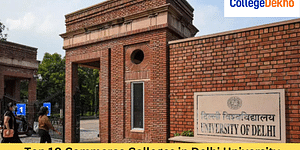BSc Fashion Design Admissions 2024
For B.Sc Fashion Design admissions, students have to qualify entrance exams like NIFT, NATA, AIEED, SMEAT, KALSEE, UCEED, etc. and have at least 50% marks in the class 12 examination. The selection process may also involve a group discussion round, a personal interview, and a portfolio session.
BSc Fashion Design Admission Overview
Obtaining a BSc Fashion Design admission at your desired institution may be the ideal educational path if you have always had a deep-seated passion for fashion and a boundless creative spirit. As a multifaceted field, Fashion Design allows for both creative freedom and technical mastery. Putting together aesthetically pleasing garments is only part of the challenge; fashion designers must also fully grasp the dynamic relationship between culture, aesthetics, functionality, and innovation. BSc Fashion Design can help you realise your creative potential and shape the way others express themselves through their wardrobe choices.
For admission to BSc Fashion Design courses after 12th grade, students must complete 10+2 with at least 50% aggregate marks. Also, they should obtain minimum cutoff marks in the required entrance exam that is recognised by their preferred university. Some popular entrance exams required for BSc Fashion Design admission are NIFT, NATA, AIEED, SMEAT, KALSEE, UCEED, and more. However, one must check all the prerequisites required by their preferred institute before enrolling. To further complete the BSc Fashion Design admission process, prospective students must submit an application form within the specified deadline, verify documents, pay the registration fee, and so on.
Table of Contents
- BSc Fashion Design Admission Overview
- BSc Fashion Design Admission Highlights
- BSc Fashion Design Eligibility
- BSc Fashion Design Fees
- BSc Fashion Design Specialisations
- BSc Fashion Design Entrance Exams
- BSc Fashion Design Selection Process
- How to Apply for BSc Fashion Design?
- Documents Required for BSc Fashion Design Admissions
- FAQs about B.Sc Fashion Design Admission Process
BSc Fashion Design Admission Highlights
When considering taking the course, it is essential to have a thorough understanding of the BSc in Fashion Design admissions requirements. Here are some key highlights to consider when applying for BSc in Fashion Design courses:
| Particulars | Details |
|---|---|
| Course Name | BSc in Fashion Design |
| Level of Programme | Undergraduate |
| Course Duration | 3 years |
| Eligibility Criteria | 50% aggregate marks in 10+2 from a recognised university |
| Admission Process | Entrance-Exam + Merit-based |
| Top Entrance Exams | NIFT, NATA, AIEED, SMEAT, KALSEE, UCEED, and more. |
| Average Course Fee | INR 50,000 to INR 3,00,000 |
| Top Colleges | Chandigarh University, JD Birla Institute, Lovely Professional University, Army Institute of Fashion and Design, CT University, MSU Vadodara, Bangalore University, etc. |
| Top Job Profiles | Costume Designer, Accessories Designer, Fashion Designer, Fashion Merchandiser, Apparel Designer, and so on. |
BSc Fashion Design Eligibility
BSc Fashion Design eligibility criteria serve as the primary requirement institutions use to evaluate applicants' suitability for their programmes. Here is a more in-depth description of the essential eligibility criteria:
Educational Qualifications: The primary eligibility criterion is the completion of 10+2 or its equivalent. This usually refers to finishing high school or secondary school. The specific qualifications and educational boards may vary from institution to institution, but the completion of 12 years of formal education is generally required.
Minimum Percentage: Many institutions stipulate a minimum percentage or grade point average (GPA) that applicants must earn on their 10+2 exam to be considered for admission. The exact percentage or GPA requirement may differ between institutions and depend on the programme's competitiveness. Some institutions may require a minimum of 50%, whereas others may seek higher percentages, such as 60% or more.
Subject Requirements: Although not always required, some institutions may stipulate certain subject prerequisites at the 10+2 level. As they pertain to the Fashion Design curriculum, these subjects may include English, Mathematics, and the Arts. Applicants are encouraged to review the specific subject requirements of their prospective schools.
Age Restrictions: In certain instances, institutions might impose age restrictions on BSc Fashion Design programmes. These restrictions can vary, but they are typically designed to ensure that applicants fall within a certain age range that corresponds to that of the typical undergraduate student.
Entrance Exams: Although not directly related to eligibility, some institutions administer entrance exams as an additional evaluative factor. Typically, meeting the minimum eligibility requirements is the first step, followed by evaluating candidates based on their performance on the entrance exam.
BSc Fashion Design Fees
One needs to be creatively inclined to work as a Fashion designer or in the field of Design. However, it is also crucial for applicants to enrol in a programme at a reputable college or university if they want to carve out a career in this industry. The majority of top government and private colleges offer this course by providing renowned faculties who encourage artistic skills. While government colleges are pocket-friendly, private institutions usually charge expensive fees. Furthermore, India's average BSc Fashion Design fees range between INR 50,000 to INR 3,00,000. It depends on many factors including the institute's reputation, location, course level, course specialisations and other infrastructural facilities provided by the college.
BSc Fashion Design Specialisations
A BSc in Fashion Design is a gateway to a wide variety of specialised fields within the fashion industry, as opposed to a singular path. This degree enables students to explore and excel in various aspects of Fashion, allowing them to tailor their education to their interests and career goals. The following are some of the most alluring BSc Fashion Design specialisations:
Fashion Styling: A concentration in Fashion Styling equips students with the ability to create compelling visual narratives through clothing and accessories. They gain experience collaborating with models, photographers, and designers to produce compelling fashion stories and editorials.
Apparel Design: This specialisation focuses on the creation of clothing and garments. Students explore the complexities of designing wearable fashion, gaining knowledge of fabric selection, pattern making, and garment construction techniques.
Textile Design: Textile design enthusiasts investigate the universe of textiles, patterns, and surface embellishments. Students explore various printing and weaving techniques as they learn to design and manufacture textiles.
Fashion Merchandising: Fashion merchandising professionals bridge the gap between business and design. They have knowledge of consumer trends, pricing strategies, and retail management to ensure that fashion products are effectively marketed.
Fashion Marketing and Management: This specialisation combines business acumen and fashion expertise. Students learn about marketing strategies, brand management, and the strategic aspects of the Fashion industry to become adept at managing fashion businesses and brands.
BSc Fashion Design Entrance Exams
When seeking admission to prestigious institutions to pursue a BSc in Fashion Design, navigating the world of entrance exams is often a crucial step. Here, we discuss some prominent BSc Fashion Design entrance exams that aspiring fashion designers may take along their educational path, including:
NIFT Entrance Exam: The National Institute of Fashion Technology (NIFT) is a prestigious institution renowned for its extensive fashion programme offerings. The NIFT entrance exam evaluates applicants' creative and analytic abilities, as well as their fashion industry knowledge, through a rigorous examination procedure.
NID Entrance Exam: The holistic design programmes at the National Institute of Design (NID) are well-known. The NID entrance exam assesses aptitude, creative thinking, and problem-solving skills, which are essential for success in the fashion design industry.
Pearl Academy Entrance Exam: The Pearl Academy of Fashion conducts its entrance exam to identify qualified candidates. The Pearl Academy entrance exam is intended to assess applicants' artistic and design-related skills, ensuring that they are adequately prepared for the academy's courses.
IIFT Entrance Exam: The Indian Institute of Fashion Technology (IIFT) provides a variety of fashion-related courses, and the IIFT entrance exam is designed to assess applicants' knowledge of fashion as well as their aptitude for design and business aspects of the fashion industry.
BSc Fashion Design Entrance Exams Schedule
The BSc Fashion Design entrance exams schedule may vary from year to year. It is essential to check with individual institutions for specific dates as listed in the table below.
| Exam Name | Registration Date | Exam Date |
|---|---|---|
| Amity School of Fashion Technology | August Last Week | July |
| Pearl Academy Entrance Exam | Early-July | Early-July |
| SMEAT | Early-July | Mid-July |
| SAT India | Early-May to Mid-May | Early-June |
| LPUNEST Scholarship | Early-November to August End | Early-February to August End |
| Chandigarh University CUCET | May Last Week to August End (Second Phase) | May Last Week to August End (Second Phase) |
| SEED | Mid-Aug | Mid-January |
| KALSEE | Mid-February to June End | June End to August End |
| DAT, MIT WPU | Mid-January to Early-August | Mid-August |
| Manipal School of Architecture and Planning | Mid-July to August End | July |
| UCEED | Mid-November | Mid-January to January End |
| UID BDes Lateral Entry | October | January End |
BSc Fashion Design Entrance Exams Syllabus
When preparing for BSc Fashion Design entrance exams, it is essential to have a thorough understanding of the diverse range of topics that these exams typically cover. These examinations assess not only your creative abilities, but also your logical reasoning, mathematical skills, general knowledge, and English proficiency. Here, we examine the key components of the Fashion Design entrance exams curriculum:
General Knowledge: As a fundamental aspect of these examinations, general knowledge questions can cover a vast array of topics, such as current events, historical occurrences, and cultural trends. A well-rounded fashion designer must have a broad knowledge of the world around them.
Mathematics: While Fashion Design is primarily a creative endeavour, a fundamental understanding of Mathematics is frequently necessary. You may encounter questions related to measurements, proportions, and calculations in these exams.
Logical Reasoning: The purpose of logical reasoning tests is to evaluate your problem-solving and critical-thinking abilities. When it comes to designing and creating innovative fashion pieces, these skills are invaluable.
Creativity and Design Aptitude: Perhaps the most critical component, this section assesses your creative instincts, design thinking, and artistic skills. To demonstrate your creative potential, you will most likely be tasked with designing or solving design-related issues.
English Language Skills: Effective communication in the fashion industry requires proficiency in the English language. This section may contain questions on grammar, vocabulary, and comprehension to ensure that you can express your ideas professionally and with clarity.
BSc Fashion Design Selection Process
The BSc Fashion Design selection process is a crucial step that determines your entrance into the world of fashion education. Typically, institutions use a combination of methods to identify promising candidates, such as evaluating academic merits, administering entrance exams, assessing your skills through interviews, reviewing your creative portfolio, and providing necessary counselling. Understanding the selection process for BSc Fashion Design admission is crucial, as it establishes the foundation for a rewarding Fashion Design career. It may include:
Merit-Based Selection: Numerous institutions evaluate applicants based on their academic performance in high school and college. Your high school grades play an important role in determining whether you meet the programme's eligibility requirements.
Entrance Exam: Some colleges and universities require applicants to take an entrance exam in fashion design. This examination assesses your design aptitude, creative ability, and fashion-related knowledge.
Interview: In addition to academic requirements, some institutions conduct interviews to evaluate your passion for fashion, communication skills, and future potential as a fashion designer.
Portfolio Review: The evaluation of your design portfolio is an integral part of the selection process. This enables evaluators to recognise your creative abilities and the calibre of your design work.
Counselling: After being chosen, candidates may participate in counselling sessions where they receive guidance on the programme and course structure and have the chance to discuss any questions or concerns. Seat allocation is also typically done during counselling.
How to Apply for BSc Fashion Design?
It can be both thrilling and tedious for an applicant to navigate through the BSc Fashion Design admission application process. Here is a quick primer on how to get started on this path, covering everything from finding a good school to submitting your application. The following steps are typically involved in the BSc in Fashion Design admission application process:
- Step 1: Research and shortlist institutions offering the programme.
- Step 2: Fill out the BSc in Fashion Design admission application form on the institution's website or offline.
- Step 3: Upload or submit the required documents.
- Step 4: Pay the BSc in Fashion Design admission fees (if any).
- Step 5: If an entrance exam is required, prepare for it and appear for the test.
- Step 6: If admission is merit-based, your academic performance will be considered.
- Step 7: Some institutions may require an interview or review of your design portfolio (if any).
- Step 8: Attend counselling sessions (if any, if required).
- Step 9: After the final selection, complete the BSc Fashion Design admission process formalities.
Documents Required for BSc Fashion Design Admissions
When completing the BSc Fashion Design admission application form, students are required to upload a soft copy of their supporting documentation (if they are applying online). They must also submit the original documents to the admission office after the merit list is released by their respective colleges. Listed below are a few common documents required for admission to BSc Fashion Design courses:
- Class 12 marksheets and certificates (if any).
- Entrance exam scorecard.
- Four to six passport-sized photographs.
- Government-issued identity proof such as an Aadhar card, passport, or driver's license.
- Residence proof.
- Caste certificate
- Income certificate.
- Character certificate.
- Portfolio (if any, may be required by some institutes).
FAQs about B.Sc Fashion Design Admission Process
What is the BSc Fashion Design fees in India?
The BSc Fashion Design fees in India range between INR 50,000 to INR 3,00,000. Generally, the fee for this course is pocket-friendly for top government colleges i.e., it ranges between INR 2,000 and INR 3,00,000. On the other hand, the fee for private colleges is quite expensive i.e., it ranges between INR 1.8 LPA and INR 7.5 LPA. If you are applying to a reputable university, you should have a work or design portfolio available.
What is the selection process for BSc Fashion Design admission?
The selection process for BSc Fashion Design admission varies from one college to another. After a student passes an entrance exam, the cutoff score of their preferred college and the Admissions Committee make an admission decision. Usually, admission to these courses is offered on a merit basis i.e., based on a student’s 10+2 scores.
What are the best colleges for BSc Fashion Design admission in India?
The best colleges for BSc Fashion Design admission in India are Chandigarh University, JD Birla Institute, Mahatma Gandhi Kashi Vidyapith, Lovely Professional University, Rathinam College of Arts and Science, Bharathiar University, Chikkanna Government Arts College, Army Institute of Fashion and Design, CT University, MSU Vadodara, Bangalore University, and more.
Is Math compulsory for BSc Fashion Design admission?
Although Math is not compulsory for BSc Fashion Design admission, the programme may require basic arithmetic skills for measurements, pattern making, and calculations related to fabric and garment construction. However, advanced math is typically not a primary requirement for most fashion design careers.
What entrance exams are a part of the BSc Fashion Design admission process?
Entrance exams that are a part of the BSc Fashion Design admission process include NIFT, NATA, AIEED, SMEAT, KALSEE, UCEED, Amity School of Fashion Technology, Pearl Academy Entrance Exam, SMEAT, SAT India, LPUNEST Scholarship, Chandigarh University CUCET, SEED, KALSEE, and so on.
What are the popular specialisations for admission to BSc Fashion Design courses?
Mainly two popular specialisations for admission to BSc Fashion Design courses are available to students that are offered by the majority of colleges. These include a degree in Fashion Business and Retail Management and a BSc in Fashion and Apparel Design.
What are the basic eligibility criteria for BSc Fashion Design admission?
The basic eligibility criteria for BSc Fashion Design admission is that candidates should complete their 10+2 from any stream with a minimum aggregate of 50% marks from any recognised board. Applicants also need to pass the entrance test (if any) and the cutoff to be considered for admission. Further, admission to a specific university requires candidates to pass a drawing and designing test.
Can I get admission to BSc Fashion Design after 12th grade?
Yes, students can get admission to BSc Fashion Design after 12th grade. For this, the primary eligibility criterion is the completion of 10+2 or its equivalent with at least 50% to 60% aggregate marks from any recognised university.
Is taking admission to BSc Fashion Design worth it?
Yes, taking admission to BSc Fashion Design is worth it for those passionate about fashion. It provides a strong foundation in design, textiles, and business, preparing students for diverse career opportunities in the fashion industry.
Who should take admission to BSc Fashion Design courses?
Students who possess a deep interest in the Fashion industry, have creativity moving through their veins and meet the eligibility requirements prescribed by their preferred university should take admission to BSc Fashion Design courses. Aside from inspiring creativity, the course also facilitates the development of numerous technical skills. Aspirants can express their visual ideas on various products throughout the course.
Popular Courses
- Courses
- B.Sc Fashion Design
- Admission Process


















